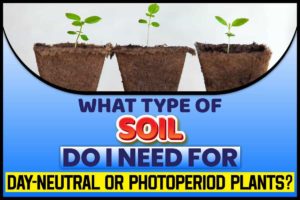
Many new growers often wonder what is the best soil for growing plants.
Well, perhaps not surprisingly the answer is a fairly complex one and significantly depends on a number of things, not least what type of plants you will be growing.
Now before you start listing off the genus and species of the specific plant you wish to grow, what I mean is will you be growing day-neutral plants or photoperiod plants?
If you haven’t heard these two phrases before, trust me you are not alone.
Photoperiod Plants
Put simply, photoperiodism is the physiological reaction of organisms, in this case plants, to the length of night or periods of darkness.
In essence, plants that are defined as photoperiod plants require specific periods of both light and darkness to allow them to efficiently and naturally grow.
Photoperiod plants can be further broken down into two categories; Long-day plants and Short-day plants.
Long-day plants like peas, barley, lettuce and wheat, will flower when the night length falls below their critical photoperiod (daylight), whereas Short-day plants flower when the night length is longer than the periods of daylight and include rice, cotton, soybeans and marijuana.
Generally speaking most photoperiod plants prefer and prosper when grown in loam soil, which, with its standard composition of 40% sand, 40% silt and 20% clay offers wonderful water retention and is rich in nutrients and oxygen.
Loam soil is one of the more expensive types of soil out there but is a reliable and trusted soil that should give your plants a good foundation.
Of course, many growers also add soil amendments to the soil during the growing process and upon flowering and these additions can help bolster, improve and increase the hydration, aeration and nutrient level that is required at that specific time.
For instance if you wish to lighten your soil and increase water retention coco coir is a go to for most growers, similarly if you wish to improve drainage and aeration within the soil, perlite is a fantastic product that comes in various sizes based upon individual need.
Many high quality and premium soils come already mixed with amendments to help boost and optimise plant growth from the outset but these will normally come with an increased price tag.
Day-Neutral Plants
Day-neutral plants do not begin to flower based upon photoperiodism, rather they initiate flowering after hitting a certain overall age or specific development stage.
Examples of day-neutral plants are cucumbers, tomatoes, roses and Ruderalis or autoflowering cannabis.
Day-neutral plants normally respond better to more aerated soil and as such a peat moss based soil, blended with both perlite and coco coir will normally produce the best results.
Peat moss is a standard component of most organic potting soils due to its excellent ability to manage water efficiently as well as retaining more nutrients on average than most other soils.
If the peat moss soil ratio in the mix is around 70% then a blend of 15% perlite and 15% coco coir will additionally allow more aeration and water retention but you can adjust these percentages to suit your specific retention rates and growing requirements.
Again, many ready made day-neutral growing soils come pre-mixed with soil amendments such as perlite, coco coir or vermiculite added as standard and it is important therefore to make a note of these percentages before growing so you can accurately adjust as and when necessary.
These pre-mixed soils often come at an additional price tag but you can buy each soil ingredient separately if you so wish and create your own specific and unique blend from scratch potentially saving you money in the long term.
Conclusion
Whilst there tends to be a slight difference in soils used dependant on if you are growing photoperiod or day-neutral plants, the basics of growing remain essentially the same; namely ensure the growing media is of the correct pH balance for your specific plants, ensure that your growing media can provide the required levels of hydration, aeration and nutrients for optimal growth and insure you have the required amendments on hand that you can quickly adapt your soil mixture should the situation require it.
In truth your soil will continue to get better and become more appropriate to your needs as you become more experienced. The above ideas act as a guide but each plant, garden and grower is different and responds better to different things.
For the experienced grower, excellent planning, a quickness to adapt and an ability to combine experience and flexibility will mean that they are well placed to overcome almost any problem that arises.








